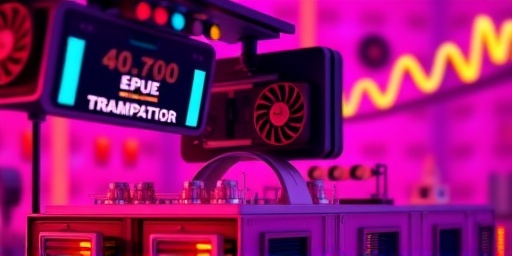Major AI Providers Slash GPU Lifespans to Five Years in Response to Tech Boom
In a seismic shift for the tech industry, leading AI infrastructure providers are resetting their GPU depreciation schedules to just five years, a move driven by the blistering pace of innovation and escalating capital expenditures. This change signals a new era where high-performance computing hardware becomes obsolete faster than ever, forcing companies to rethink their financial strategies amid the AI factories boom. As giants like NVIDIA, Google Cloud, and Microsoft Azure pour billions into expanding their data centers, the traditional longer depreciation periods—often seven to ten years—are being abandoned to better align with the rapid evolution of AI technologies.
- Major AI Providers Slash GPU Lifespans to Five Years in Response to Tech Boom
- Capital Expenditure Explosion Reshapes AI Infrastructure Landscape
- Operating Cash Flow Emerges as Key Metric for AI Sustainability
- Rapid Innovation Cycles Challenge Traditional Economic Models in AI
- Investors Eye Sustainable Growth Paths for AI Infrastructure Future
The announcement comes at a time when capital expenditure, or CapEx, in AI infrastructure has surged by over 40% year-over-year, according to recent reports from industry analysts at Gartner. This acceleration is not merely a response to demand but a proactive adaptation to the economic realities of building and maintaining AI factories—massive facilities dedicated to training and deploying artificial intelligence models. For investors, the message is clear: traditional metrics like asset longevity may no longer suffice. Instead, operating cash flow is emerging as the critical indicator of whether these ambitious builds can sustain long-term profitability.
At the heart of this transformation is the GPU, the graphics processing unit that powers the parallel computing essential for AI workloads. Previously depreciated over extended periods to spread costs, GPUs are now being written down much quicker due to advancements in chip design and software optimization. NVIDIA CEO Jensen Huang highlighted this during a recent earnings call, stating, ‘The velocity of AI innovation means our hardware must evolve just as quickly. A five-year cycle reflects the true economic life of these assets in our AI factories.’
This isn’t just a bookkeeping adjustment; it’s a reflection of broader market dynamics. With global AI spending projected to hit $200 billion by 2025, per IDC forecasts, the pressure to deploy cutting-edge infrastructure is immense. Companies are racing to secure market share in cloud AI services, where even a six-month delay in hardware upgrades could mean losing ground to competitors.
Capital Expenditure Explosion Reshapes AI Infrastructure Landscape
The surge in capital expenditure is rewriting the rules for AI factories, with major players committing unprecedented sums to build out their computing ecosystems. Microsoft, for instance, revealed plans to invest $56 billion in AI infrastructure this fiscal year alone, a figure that dwarfs previous outlays and underscores the CapEx frenzy. This influx is funding everything from massive GPU clusters to energy-efficient cooling systems, as AI factories consume power equivalent to small cities.
Google’s parent company, Alphabet, echoed this trend by allocating $12 billion quarterly to data center expansions, explicitly tying the spend to accelerating AI model training capabilities. ‘Our CapEx is not just about scale; it’s about staying ahead in an industry where GPU depreciation accelerates with every breakthrough,’ said Ruth Porat, Alphabet’s CFO, in a statement to investors. These investments are propelling the growth of AI factories, specialized facilities optimized for machine learning tasks, but they also introduce financial strains that shorter depreciation schedules aim to address.
Analysts point to a 60% increase in GPU procurement costs over the past 18 months, driven by supply chain bottlenecks and heightened demand from hyperscalers. This has led to a reevaluation of how infrastructure assets are valued on balance sheets. Under the new five-year GPU depreciation model, companies can more accurately expense these costs, potentially improving short-term earnings visibility while highlighting the need for robust operating cash flow to fund ongoing expansions.
Yet, this CapEx surge isn’t without risks. Energy demands for AI factories are skyrocketing, with estimates from the International Energy Agency suggesting that data centers could account for 8% of global electricity by 2030. Providers are countering this by integrating renewable energy sources and advanced cooling tech, but the upfront costs further justify the accelerated depreciation approach. For smaller players entering the AI infrastructure space, the barrier to entry is higher than ever, potentially consolidating the market around a few dominant AI factories operators.
Operating Cash Flow Emerges as Key Metric for AI Sustainability
As GPU depreciation shortens and capital expenditure balloons, savvy investors are zeroing in on operating cash flow as the litmus test for AI factory viability. Unlike revenue growth, which can be inflated by one-time deals, operating cash flow reveals the true health of day-to-day operations—crucial when massive CapEx investments demand continuous funding. Wall Street firms like Goldman Sachs are advising clients to prioritize this metric, warning that companies overly reliant on debt-financed infrastructure may falter in a high-interest-rate environment.
Take Amazon Web Services (AWS), which reported a robust $25 billion in operating cash flow last quarter, up 15% from the prior year. This influx has enabled AWS to sustain its AI infrastructure push without diluting shareholder value through excessive stock issuance. ‘Operating cash flow is the oxygen for our AI factories,’ noted AWS CEO Matt Garman. ‘It ensures we can depreciate GPUs over five years while scaling without compromising innovation.’
Industry experts emphasize that this focus is particularly vital amid economic uncertainty. A Deloitte survey of 200 tech executives found that 72% now view operating cash flow as more predictive of long-term success than traditional depreciation models. For AI infrastructure providers, generating positive cash flow means covering not just GPU replacements but also the ancillary costs of AI factories, such as talent acquisition and R&D.
However, not all companies are positioned equally. Startups in the AI space, like those building specialized GPU clusters, often burn through cash with negative operating flows, relying on venture capital. The shift to five-year depreciation could exacerbate this, as faster write-offs reduce reported assets and heighten scrutiny from funders. Investors are urged to dissect quarterly filings for signs of cash generation efficiency, especially as CapEx commitments lock in billions for years ahead.
Rapid Innovation Cycles Challenge Traditional Economic Models in AI
The pivot to five-year GPU depreciation is symptomatic of deeper changes in the economic models underpinning AI infrastructure. Rapid innovation—fueled by breakthroughs in transformer architectures and quantum-inspired computing—has compressed technology lifecycles, rendering yesterday’s hardware inadequate for tomorrow’s AI demands. This isn’t hyperbole; NVIDIA’s latest H100 GPUs, for example, offer 9x the performance of their predecessors, justifying quicker obsolescence.
In AI factories, where workloads involve processing petabytes of data for models like GPT-4, the need for constant upgrades is non-negotiable. Providers are adopting modular designs that allow hot-swapping of GPUs, minimizing downtime but accelerating depreciation schedules. A report from McKinsey estimates that this agility could boost AI deployment speeds by 30%, but it demands a cultural shift toward viewing infrastructure as a fluid asset rather than a fixed one.
Quotes from sector leaders underscore the urgency. AMD’s Lisa Su remarked, ‘In the AI era, GPU depreciation isn’t a cost—it’s an investment in relevance.’ Meanwhile, challenges persist: supply chain vulnerabilities, highlighted by the 2022 chip shortage, could delay CapEx returns and strain operating cash flow. Geopolitical tensions, including U.S.-China trade restrictions on advanced semiconductors, add another layer of complexity to global AI factories expansion.
Regulatory scrutiny is also ramping up. The European Union’s AI Act, set for implementation in 2024, mandates transparency in high-risk AI systems, potentially increasing compliance costs for infrastructure providers. These factors collectively push companies to optimize their economic models, with shorter GPU depreciation serving as a tool to navigate the turbulence.
Investors Eye Sustainable Growth Paths for AI Infrastructure Future
Looking ahead, the reset in GPU depreciation schedules positions AI factories for a more resilient future, but only if providers master the balance between aggressive CapEx and steady operating cash flow. Analysts forecast that by 2027, the global AI infrastructure market will exceed $500 billion, with sustainable models separating winners from laggards. Companies like Tesla, leveraging its Dojo supercomputer for autonomous driving AI, are already demonstrating how integrated cash flow management can fuel innovation without overextension.
Emerging trends point to hybrid infrastructure solutions, blending on-premises AI factories with edge computing to distribute CapEx loads. This could mitigate depreciation risks by diversifying asset bases. Moreover, partnerships—such as Intel’s collaboration with hyperscalers on custom silicon—aim to standardize GPU upgrades, potentially stabilizing economic models across the board.
For investors, the road map is straightforward: monitor operating cash flow trends closely, as they will dictate which AI infrastructure players thrive amid the CapEx surge. As one Morgan Stanley analyst put it, ‘The five-year GPU cycle is a wake-up call—sustainability in AI factories hinges on cash, not just compute power.’ With innovation unrelenting, the sector’s trajectory promises transformative growth, provided financial discipline keeps pace.









